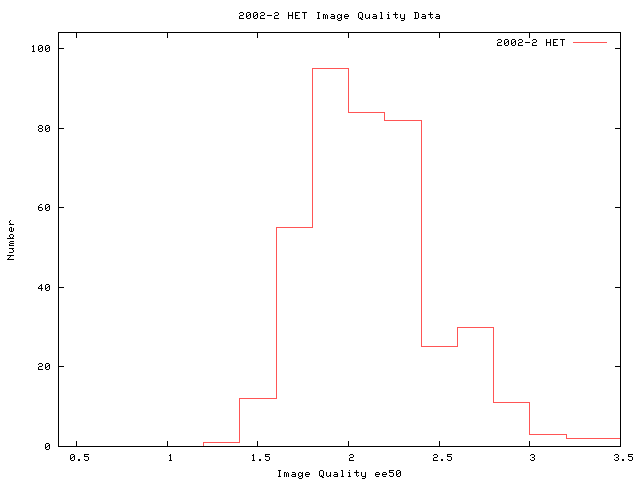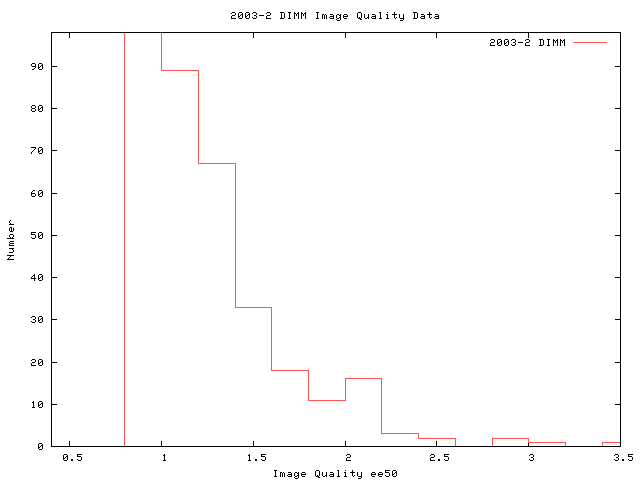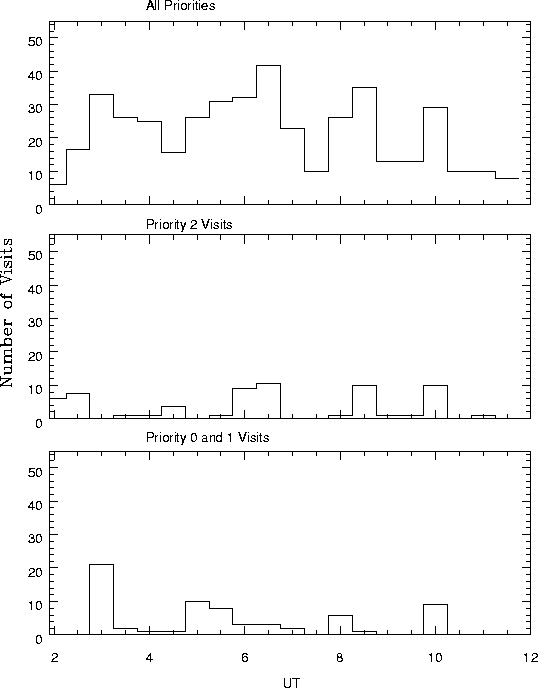
In this section we will discuss the status of each instrument and any limitation to configurations that occurred during the period.
The following image quality statistics were taken from the statistics recorded for science operations in the night report.

For comparison here is the image quality for the same period of 2002

Here are the DIMM values reported in the night report.

Month by Month Summary
The following table gives the observing statistics for each month. The second column gives the fraction of the month that was spent attempting science (as opposed to engineering or instrument commissioning). Science time is defined to begin at 18 degree twilight or the first science target. Science time is defined to end at 18 degree twilight or the last science target. The fourth column gives the fraction of the possible science time (A) lost due to weather. The fifth through seventh columns give the amount of remaining science time (after removing weather losses) not spent attempting science targets. Please note that the first stack of the night often occurs before 18 degree twilight.
| Month | A:Fraction of the Time that was Possible Science | B:Average Night Length | C:Fraction of Total Science Time Lost due to Weather | D:Fraction of Actual Science Time Lost due to Alignment | E:Fraction of Actual Science Time Lost due to Calibrations | F:Fraction of Actual Science Time Lost due to Problems | Fraction of Actual Science Time Not accounted for or Lost |
|---|---|---|---|---|---|---|---|
| April | 0.601 | 8.27 | 0.26 | 0.07 | 0.05 | 0.10 | 0.03 |
The last column is new and acounts for all of the lost or not used minutes. Some of this time is accounting errors and some is time not charged to any program due to operations inefficiency.
Details on Nightly cloud cover based on the TO's observations of the sky reported 3 times a night in the night report.:
| Month | Fraction of the Nights that were Clear | Fraction of the Nights that were Mostly Clear | Fraction of the Nights that were Partly Cloudy | Fraction of the Nights that were Mostly Cloudy | Fraction of the Nights that were Cloudy |
|---|---|---|---|---|---|
| April | 0.37 | 0.27 | 0.23 | 0.03 | 0.10 |
Please note that the HET could be closed due to humidity, smoke or high dust count and still have a "Clear" statistic in the night report.
The total number of 481 acceptable shutter open science exposures during this period for a total of 47.0 hours. There were a number of rejected spectra obtained during this period as well the following table give the total number of rejected spectra and the category that each falls into.
| Number of Times | Time Lost (Hours) | Type |
|---|---|---|
| 2 | 0.9 | E - Rejected by RA for Equipment Failure |
| 6 | 1.9 | H - Rejected by RA for Human failure |
| 62 | 6.3 | W - Rejected by RA for Weather |
| 3 | 0.8 | P - Rejected by PI and confirmed by RA |
| 1 | 0.2 | Q - Rejected due to error in the queue |
| 0 | 0.0 | C - Acceptable by RA but PI rejects |
| 2 | 0.4 | N - Acceptable but NOT charged due to weather or hole in queue |
| 8 | 1.3 | B - Acceptable but Border line conditions |
So this is a total of 10.4 hours of rejected spectra with an additional possible 1.3 hours of spectra that may be rejected.
The following overhead statistics include slew, setup, readout and refocus between exposures (if there are multiple exposures per visit). In the summary page for each program the average setup time is calculated. The table below gives the average setup time for each instrument PER VISIT and the average and maximum COMPLETED science exposures and visits.
The "Exposure" is defined by when the CCD opens and closes. A "Visit" is the requested total CCD shutter open time during a track and might be made up of several "Exposures". "Visit" as defined here contains no overhead. To calculate one type of observing efficiency metric one might divide the "Visit" by the sum of "Visit" + "Overhead".
| Instrument | Avg Overhead (min) | Median Overhead (min) | Avg Exposure (sec) | Median Exposure (sec) | Max Exposure (sec) | Avg Visit (sec) | Median Visit (sec) | Max Visit (sec) |
|---|---|---|---|---|---|---|---|---|
| LRS | 15.4 | 14.8 | 722.2 | 600 | 2700 | 1031.5 | 600 | 4200 |
| HRS | 10.7 | 9.3 | 674.6 | 1200 | 1800 | 1190.3 | 1200 | 3900 |
The overhead statistics can be shortened by multiple setups (each one counted as a seperate visit) while on the same target as is the case for planet search programs. The overhead statistics can be lengthened by having multiple tracks that add up to a single htopx visit as can happen for very long tracks where each attempt might only yield a half visit.
The following links give the summary for each institution and its programs.
The resulting table will give (for each program) the total number of targets
in the queue and the number completed, the CCD shutter open
hours, average overhead for that program, and the TAC allocated time.
This usually will be the best
metric for judging completeness but there are times when a PI will tell
us that a target is "done" before the total number of visits is complete.
The following is a summary of the Acceptable CCD shutter time for each
institution based on our htopx data base. It does not include any
overhead.
Observing Programs Status
Program comments:
UT03-2-003: (Gerardy) TOO SN program.
UT03-2-004: (Wheeler) TOO SN program.
UT03-2-005: (Wheeler) TOO GRB program.
UT03-2-006: (Drory) LRS MOS G3 program.
UT03-2-007: (Tufts) Program complete.
UT03-2-010: (Hynes) LRS g2 program.
UT03-2-015: (Cochran) Synoptic Program for June.
UT03-2-016: (Barnes) Synoptic program targets in late June.
Program comments:
PSU03-2-001: (Eracleous) TOO GRB program.
PSU03-2-003: (Brandt) Synoptic Program.
PSU03-2-015: (Vignali) Synoptic Program, all targets on hold.
PSU03-2-016: (Brandt) LRS G3 Program.
PSU03-2-018: (Abel) LRS G3 Program.
PSU03-2-019: (Lewis) MRS Program.
PSU03-2-020: (Eracleous) LRS G3 Program.
PSU03-2-021: (Eracleous) LRS G3 Program.
PSU03-2-022: (Gronwal) LRS G2 Program.
PSU03-2-023: (Ciardullo) MRS Program.
PSU03-2-024: (Chakraborty) MRS Program.
PSU03-2-027: (Stark) MRS Program.
PSU03-2-028: (TAC) TAC extra time.
Program comments:
STA03-2-002: (Petrosian) LRS mos program.
STA03-2-003: (Thompson) Program terminated by PI.
Program comments:
MUN03-2-001: (Thomas) LRS g2 program
Program comments:
There are no new programs in this period.
G03-2-001: (Kollatschny) Synoptic LRS g2 program
Institution Status
| CCD shutter Open by Institution (hours) | ||||
|---|---|---|---|---|
| -TOTAL- | Used | % of All | ||
| PSU | 16.217 | 32.5 | ||
| UT | 13.889 | 27.9 | ||
| Stanford | 7.083 | 14.2 | ||
| Munich | 10.417 | 20.9 | ||
| Goetting | 2.250 | 4.5 | ||
| NOAO | 15.594 | -- | ||
| SALT | 0.000 | -- | ||
| DDT | 0.000 | -- | ||
The following is a summary of the total charged time for each institution based on our htopx data base (for shutter open) and night reports (for overhead). It includes shutter open time and overhead.
| Time Charged by Institution (hours) | ||||
|---|---|---|---|---|
| -TOTAL- | Used | % of All | ||
| PSU | 29.53 | 37.3 | ||
| UT | 21.41 | 27.0 | ||
| Stanford | 11.91 | 15.0 | ||
| Munich | 13.49 | 17.0 | ||
| Goetting | 2.93 | 4.1 | ||
| NOAO | N/A | -- | ||
| SALT | 0.00 | -- | ||
| DDT | 0.00 | -- | ||
This is how each institution has allocated its time by priority.
| Time Allocation by Institution (hours) | |||||
|---|---|---|---|---|---|
| Institution | Priority 0 | Priority 1 | Priority 2 | Priority 3 | Priority 4 |
| PSU | 6.000 (5%) | 26.800 (21%) | 26.700 (21%) | 27.000 (21%) | 42.830 (33%) |
| UT | 21.160 (13%) | 29.500 (18%) | 44.800 (27%) | 41.000 (25%) | 29.000 (18%) |
| Stanford | 0.000 | 7.000 (32%) | 7.000 (32%) | 4.000 (18%) | 4.000 (18%) |
| Munich | 0.000 | 0.000 | 0.000 | 0.000 | 0.000 |
| Goetting | 0.000 | 0.000 | 0.000 | 0.000 | 0.000 |
| NOAO | 0.000 | 31.220 (56%) | 18.360 (33%) | 6.000 (11%) | 0.000 |
| SALT | 0.000 | 0.000 | 0.000 | 0.000 | 0.000 |
| DDT | 0.000 | 0.000 | 0.000 | 0.000 | 0.000 |
| UT03-2 | ||
|---|---|---|
| Rank | Program | Constraints |
| 1 | UT03-2-010 V404_Cyg | LRS, G2 , Vsky > 20.0 ,EE50 < 4.0 |
| 2 | UT03-2-018 various TOOT12 | LRS targets, Vsky > 20.4, EE50 < 2.4 |
| 3 | UT03-2-013 CI_Aql | HRS targets, Vsky > 20.7, EE50 < 2.3 |
| PSU03-2 | ||
|---|---|---|
| Rank | Program | Constraints |
| 1 | PSU03-2-002 112303.12+081704.8 | LRS G3, Vsky > 20.5, EE50 < 2.0 near twilight |
| STA03-2 | ||
|---|---|---|
| Rank | Program | Constraints |
| 1 | STA03-2-001 J0205+1444 | LRS G2, Vsky > 20.0 , EE50 < 2.0 in July |
| 2 | STA03-2-002 (4 objects) | LRS MOS, Vsky > 20.5 , EE50 < 2.2 in June |
| MUN03-2 | ||
|---|---|---|
| Rank | Program | Constraints |
| 1 | MUN03-2-001 (4 priority 1) | LRS g2, Vsky > 20.7, EE50 < 3.0, |
| G03-2 | ||
|---|---|---|
| Rank | Program | Constraints |
| 1 | G03-2-001 | LRS, Synoptic target every 1-2 days for 17 more visits, Vsky > 18.0 , EE50 < 4.0 |

The following histogram shows some of the extrema in observing conditions: good seeing dark time, bright time and bad seeing dark time. There will be a problem later in the trimester with a lack of bright time targets.
